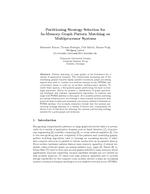Inproceedings3146: Unterschied zwischen den Versionen
Aus International Center for Computational Logic
Alexander Krause (Diskussion | Beiträge) (Die Seite wurde neu angelegt: „{{Publikation Erster Autor |ErsterAutorVorname=Alexander |ErsterAutorNachname=Krause |FurtherAuthors=Thomas Kissinger; Dirk Habich, Hannes Voigt, Wolfgang Lehn…“) |
Markus Krötzsch (Diskussion | Beiträge) Keine Bearbeitungszusammenfassung |
||
| (Eine dazwischenliegende Version von einem anderen Benutzer wird nicht angezeigt) | |||
| Zeile 2: | Zeile 2: | ||
|ErsterAutorVorname=Alexander | |ErsterAutorVorname=Alexander | ||
|ErsterAutorNachname=Krause | |ErsterAutorNachname=Krause | ||
|FurtherAuthors=Thomas Kissinger; Dirk Habich | |FurtherAuthors=Thomas Kissinger; Dirk Habich; Hannes Voigt; Wolfgang Lehner | ||
}} | }} | ||
{{Inproceedings | {{Inproceedings | ||
|Referiert=1 | |Referiert=1 | ||
|Title=Partitioning Strategy Selection for In-Memory Graph Pattern | |Title=Partitioning Strategy Selection for In-Memory Graph Pattern Matching on Multiprocessor Systems | ||
|To appear=1 | |To appear=1 | ||
|Year=2017 | |Year=2017 | ||
| Zeile 13: | Zeile 13: | ||
}} | }} | ||
{{Publikation Details | {{Publikation Details | ||
|Abstract=Pattern matching on large graphs is the foundation for a variety of application domains. The continuously increasing size of the underlying graphs requires highly parallel in-memory graph processing engines that need to consider non-uniform memory access (NUMA) and concurrency issues to scale up on modern multiprocessor systems. To tackle these aspects, a fine-grained graph partitioning becomes increasingly important. Hence, we present a classification of graph partitioning strategies and evaluate representative algorithms on medium and large-scale NUMA systems in this paper. As a scalable pattern matching processing infrastructure, we leverage a data-oriented architecture that preserves data locality and minimizes concurrency-related bottlenecks on NUMA systems. Our in-depth evaluation reveals that the optimal partitioning strategy depends on a variety of factors and consequently, we derive a set of indicators for selecting the optimal partitioning strategy suitable for a given graph and workload. | |Abstract=Pattern matching on large graphs is the foundation for a variety of application domains. The continuously increasing size of the underlying graphs requires highly parallel in-memory graph processing engines that need to consider non-uniform memory access (NUMA) and concurrency issues to scale up on modern multiprocessor systems. To tackle these aspects, a fine-grained graph partitioning becomes increasingly important. Hence, we present a classification of graph partitioning strategies and evaluate representative algorithms on medium and large-scale NUMA systems in this paper. As a scalable pattern matching processing infrastructure, we leverage a data-oriented architecture that preserves data locality and minimizes concurrency-related bottlenecks on NUMA systems. Our in-depth evaluation reveals that the optimal partitioning strategy depends on a variety of factors and consequently, we derive a set of indicators for selecting the optimal partitioning strategy suitable for a given graph and workload. | ||
|Download=Europar-2017.pdf | |Download=Europar-2017.pdf | ||
|Projekt=HAEC B08 | |Projekt=HAEC B08 | ||
|Forschungsgruppe=Wissensbasierte Systeme | |Forschungsgruppe=Wissensbasierte Systeme | ||
}} | }} | ||
Aktuelle Version vom 27. Juli 2017, 13:45 Uhr
Partitioning Strategy Selection for In-Memory Graph Pattern Matching on Multiprocessor Systems
Alexander KrauseAlexander Krause, Thomas KissingerThomas Kissinger, Dirk HabichDirk Habich, Hannes VoigtHannes Voigt, Wolfgang LehnerWolfgang Lehner
Alexander Krause, Thomas Kissinger, Dirk Habich, Hannes Voigt, Wolfgang Lehner
Partitioning Strategy Selection for In-Memory Graph Pattern Matching on Multiprocessor Systems
23rd International Conference on Parallel and Distributed Computing, Santiago de Compostela, Spain, to appear
Partitioning Strategy Selection for In-Memory Graph Pattern Matching on Multiprocessor Systems
23rd International Conference on Parallel and Distributed Computing, Santiago de Compostela, Spain, to appear
- KurzfassungAbstract
Pattern matching on large graphs is the foundation for a variety of application domains. The continuously increasing size of the underlying graphs requires highly parallel in-memory graph processing engines that need to consider non-uniform memory access (NUMA) and concurrency issues to scale up on modern multiprocessor systems. To tackle these aspects, a fine-grained graph partitioning becomes increasingly important. Hence, we present a classification of graph partitioning strategies and evaluate representative algorithms on medium and large-scale NUMA systems in this paper. As a scalable pattern matching processing infrastructure, we leverage a data-oriented architecture that preserves data locality and minimizes concurrency-related bottlenecks on NUMA systems. Our in-depth evaluation reveals that the optimal partitioning strategy depends on a variety of factors and consequently, we derive a set of indicators for selecting the optimal partitioning strategy suitable for a given graph and workload. - Projekt:Project: HAEC B08
- Forschungsgruppe:Research Group: Wissensbasierte SystemeKnowledge-Based Systems
@inproceedings{KKHVL2017,
author = {Alexander Krause and Thomas Kissinger and Dirk Habich and Hannes
Voigt and Wolfgang Lehner},
title = {Partitioning Strategy Selection for In-Memory Graph Pattern
Matching on Multiprocessor Systems},
booktitle = {23rd International Conference on Parallel and Distributed
Computing, Santiago de Compostela, Spain},
year = {2017},
month = {August}
}
